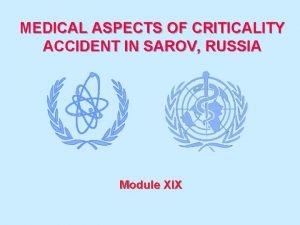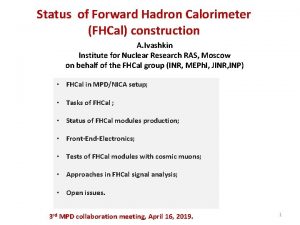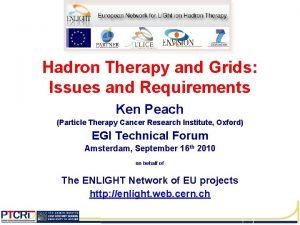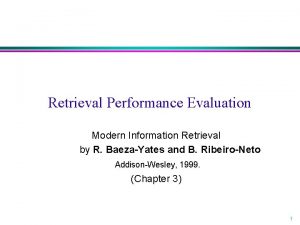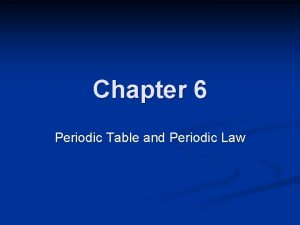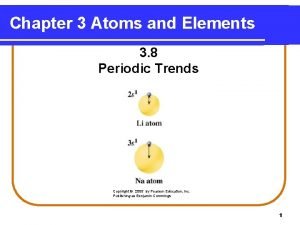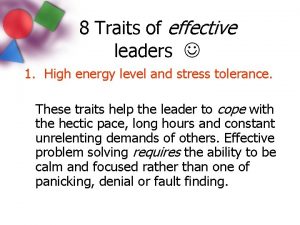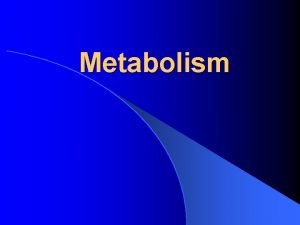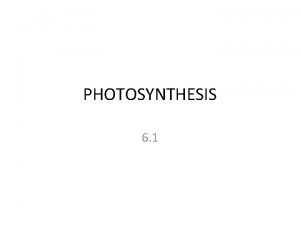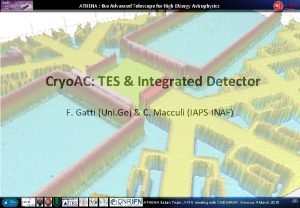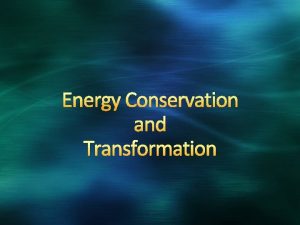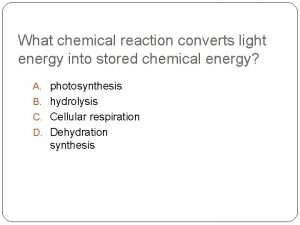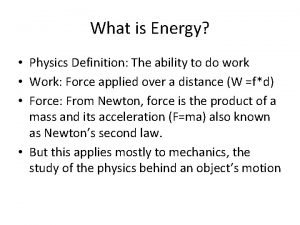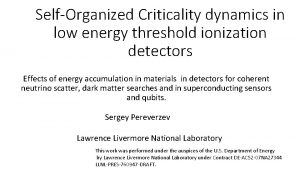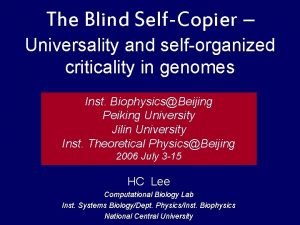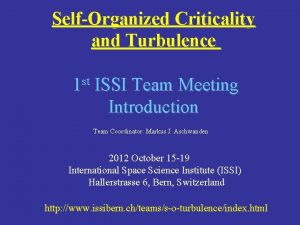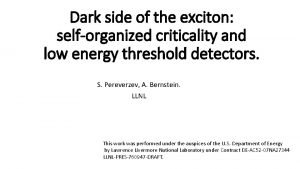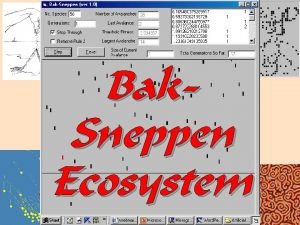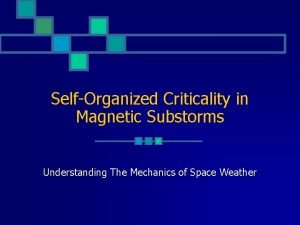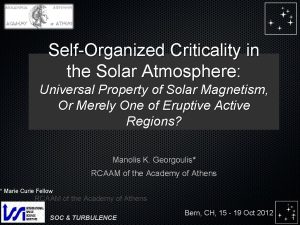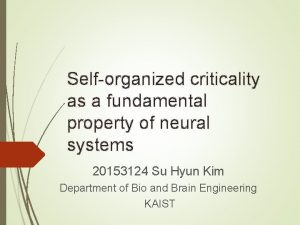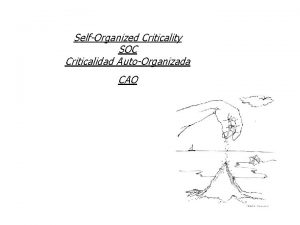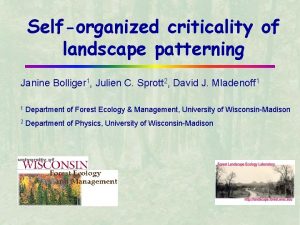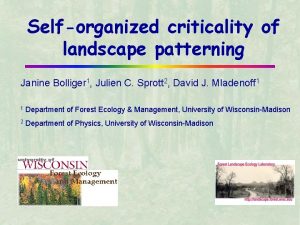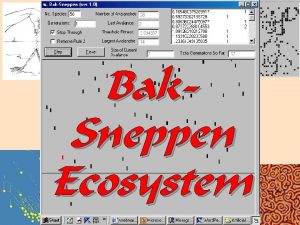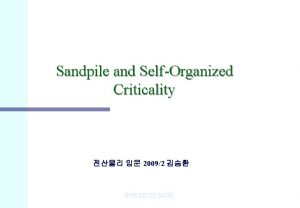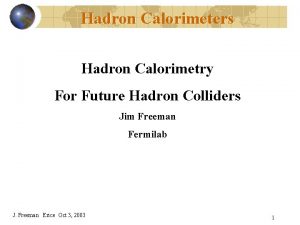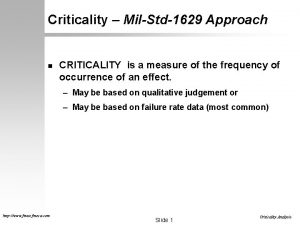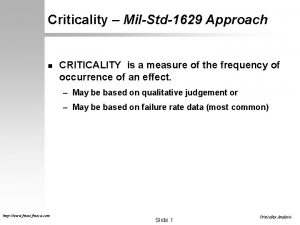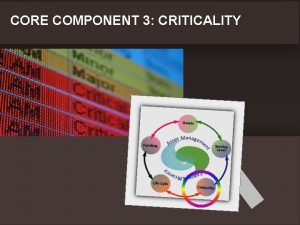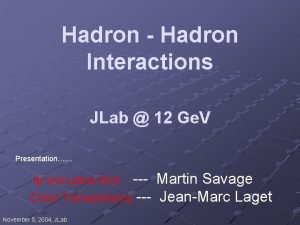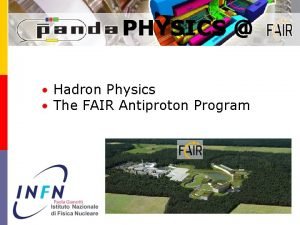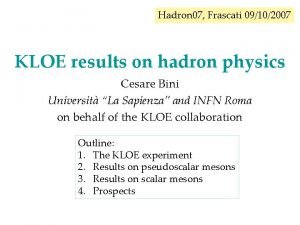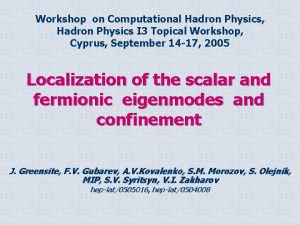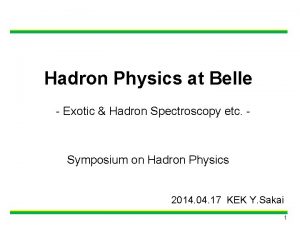High Energy Hadron Production As SelfOrganized Criticality An


















































- Slides: 50

High Energy Hadron Production As Self-Organized Criticality: An Absorbing State Phase transition P. Castorina Italian Institute for Nuclear Research - Catania - Italy and Institute of Particle and Nuclear Physics, Faculty of Mathematics and Physics, Charles University, Prague, Czech Republic Paolo Castorina and Helmut Satz ar. Xiv: 1901. 10407

High Energy Hadron Production As Self-Organized Criticality: An absorbing state phase transition Statistical model in high energy collisions : a new (? ) puzzle Self organized criticality (SOC) and Absorbing State phase transition Hadronization and Color Absorbing State Simple models Results

ar. Xiv: 0901. 3643 An introduction to the Statistical Hadronization Model F. Becattini In the grand-canonical formulation of the statistical model, the mean hadron multiplicities are defined as Fireball volume Strangeness Number of suppression s or anti-s Chemical Freeze –out Temperature = hadronic abundances get frozen chemical potentials

First, a primary hadron yield is calculated using previous equations. As a second step, all resonances in the gas which are unstable against strong decays are allowed to decay into lighter stable hadrons, using appropriate branching ratios (B) for the decay k → j published by the PDG. The abundances in the final state are thus determined by Masses and widths At zero temperature

T = 155 Me. V 9 orders of magnitude fm Nature 561 (2018) 321 -330 A. Andronic, P. Braun-Munzinger, K. Redlich, J.



Critical temperature About 160 Me. V

The basic question is: Why are the yields for the production of light nuclei determined by the rates as specified at the critical hadronization temperature, although in hot hadron gas they would immediately be destroyed? Composite objects such are formed at the phase boundary as compact multi-quark A. Andronic, P. Braun-Munzinger, K. Redlich, J. Stachel Nature 561 (2018) 321 -330 D. Oliinychenko – Snowball from hell – this conference Coalescence Where light nuclei are formed due to final state interactions after a fireball decay. Recente review P. Braun-Munzinger and B. Donigus Loosely-bound objects produced in nuclear collisions at LHC Nucl. Phys. A 987 (2019) 144 -201 and refs. therein Analogy with nucleosyntesis Vovchenko, Gallmeister, Schaner-Bielich and Greiner, ar. Xiv 1903. 10024

A solution to this puzzle can be obtained by abandoning the idea of a thermal hadron medium existing below the confinement point: The hot quark-gluon system, when it cools down to the hadronization temperature, is effectively quenched by the cold physical vacuum. The relevant basic mechanism for this is selforganized criticality. P. C. and H. Satz - ar. Xiv: 1901. 10407

SELF-ORGANIZED CRITICALITY The core hypothesis is that systems consisting of many interacting components will, under certain conditions, spontaneously organize into a state with properties akin to the ones observed in a equilibrium thermodynamic system. As this complex behavior arises spontaneously without the need for external tuning ( the temperature for example) this phenomena was named Self-Organized Criticality (SOC). These are systems whose natural dynamics drives them towards, and the maintains them at the edge of stability.

WELL KNOWN EXAMPLES IN NATURE – POWER LAWS SOC refers to the spontaneous organization of a system driven from the outside into a globally stationary state, which is characterized by self-similar distributions of event sizes and fractal geometrical properties SOC Sandpile avalanche size SOC Earthquakes Cambridge lecture notes pag 22 Self-Organized criticality-Theory, Models and Characterization G. Pruessener, Cambridge U. P. Power laws and Self-Organized Criticality in Theory and Nature, D. Markovic and C. Gros, ar. Xiv: 1310. 5527

Another example In general


Absorbing state However, for non-equilibrium steady states it is becoming increasingly evident that SOC is related to conventional critical behavior, namely that one of an absorbing-state phase transition Haye Hinrichsen - Non Equilibrium Critical Phenomena and Phase Transitions into Absorbing States, ar. Xiv 0001070. - LECTURE NOTES : Non-equilibrium phase transitions Absorbing state : configurations that can be reached by the dynamics but cannot be left Example: models describing the growth of bacterial colonies or the spreading of an infectious disease among a population Once an absorbing state, e. g. , a state in which all the bacteria are dead, is reached, the system cannot escape from it. and Absorbing state phase transitions are among the simplest non-equilibrium phenomena displaying critical behavior and universality. et al – arxive 1611. 03288 et al – arxive 0901. 451

Hadronization and Absorbing State Phase Transition Veneziano, Amati

System evolution Deconfinement: Local Color charges Color singlet HADRONS Absorbing State One – Way evolution : NO COLOR CHARGE AFTER HADRONIZATION

Hadronization is an Absorbing State Phase Transition for Color charge Non-equilibrium phase transition

Is there a hidden Absorbing State in the «usual» statitistical hadronization model ? YES

A simple model Color charge density / parton number density Hadron


Same model for first order phase transition Landau-Ginzburg Theory of Self-Organized Criticality L. Gil and D. Sornette PRL 76 (1996) 3991 et al. ar. Xiv 1605. 05161

Polyakov Loop dynamics - SU(3) gauge theory – no dynamical quark 0 ar. Xiv 1705. 00718

Polyakov Loop dynamics - SU(3) A. Dumitru, R. D. Pisarski ar. Xiv: 0209001 O. Scavenius, A. Dumitru, J. T. Lenaghan ar. Xiv: 0201079 Absorbing state

Order parameter Hadrons Deconfined phase Control parameter (for example, Temperature)

1) The Hadronization mechanism is a non equilibrium phase transition to an Absorbing State 2) The dynamical evolution is driven by color d. o. f. up to the hadronization time/temperature 3) Due to the absorbing state the system is essentially «frozen» at the values of the parameters at the transition Universal scaling behavior of non-equilibrium phase transitions, Sven Lubeck, International Journal of Modern Physics B 18, 3977 (2004) Critical Dynamics , U. C. Tauber, Cambrideg University Press

Particle Yields in high energy collisions – non equilibrium Statistical model

In SOC avalanche dynamics , the size distribution follows a power law What is the statistical «size» associated to a hadron of mass M «size» density of state of mass M The yield of a hadron of mass M is therefore determined by the density of state of mass M at the absorbing state , i. e. at the hadronization/deconfinement temperature T_c More precisely…

i

Cluster can be considered as clusters of colorless clusters done by clusters of colorless clusters…. . 140 Me. V

previous equations are due to

The emergent picture is a sudden quench of the partonic medium at the absorbing state << >>

RESULTS Self-Organized Criticality suggests for the yield of a hadron of mass m

NO EQUILIBRIUM THERMAL SYSTEM OF ANY KIND IS ASSUMED COMPARISON WITH ALICE DATA

0 PRIMARY PRODUCTION

Comment 1 - Nuclear Physics – SOC in multifragmentation? * * *

Conclusions and outlook 1) The Hadronization mechanism is a non equilibrium phase transition to an Absorbing State 2) The dynamical evolution is driven by color d. o. f. up to the hadronization time/temperature 3) Due to the absorbing state the system is «frozen» at the values of the parameters at the transition Light nuclei /hypernuclei are produced at T_c and survive There is no hadron resonance gas after * deconfinement transition or a very short-lived one 4) Is there some peculiar behaviour related to the presence of the absorbing state? 5) SOC in nuclear fragmentation? * P. Braun-Munzinger, J. Stachel and Ch. Wetterich, Phys. Lett. B 596 (1994) 61.

Auxiliary material



All high energy collisions Universal Strangeness Production in Hadronic and Nuclear Collisions P. Castorina, S. Plumari, H. Satz Int. J. Mod. Phys. E 25 (2016) no. 08, 1650058

RECALL - EQUILIBRIUM LATTICE QCD But for m_q=0


Direct Percolation DP



Bootstrap


Comment 2 : Transverse momentum distribution Arxiv: nucl-th/0106050 SOC in transverse momentum distribution?

The most important universality class of absorbingstate transitions is directed percolation (DP) Critical Dynamics , U. C. Tauber, Cambrideg University Press A Field Theory Approach to Equilibrium and Non-Equilibrium Scaling Behavior Universal scaling behavior of non-equilibrium phase transitions, Sven Lubeck, International Journal of Modern Physics B 18, 3977 (2004) The effective action describing the critical behavior of DP universality class is the Reggeon Field Theory -
 Jelaskan proses pembuatan multimedia content production
Jelaskan proses pembuatan multimedia content production Service criticality
Service criticality The sarov criticality
The sarov criticality Criticality analysis and risk assessment
Criticality analysis and risk assessment Hadron calorimeter
Hadron calorimeter Hadron collider
Hadron collider Hadron collider
Hadron collider Hadrons
Hadrons Hadron
Hadron Energy energy transfer and general energy analysis
Energy energy transfer and general energy analysis Energy energy transfer and general energy analysis
Energy energy transfer and general energy analysis High precision vs high recall
High precision vs high recall High precision vs high recall
High precision vs high recall Directive and supportive leadership
Directive and supportive leadership High expectations high support
High expectations high support High precision vs high accuracy
High precision vs high accuracy High directive and high supportive behavior
High directive and high supportive behavior Investasi adalah
Investasi adalah The periodic table and periodic law chapter 6
The periodic table and periodic law chapter 6 Largest atomic radius
Largest atomic radius High energy leadership traits
High energy leadership traits High energy electrons
High energy electrons Energy star multifamily high rise
Energy star multifamily high rise østomata
østomata Energy star multifamily high rise
Energy star multifamily high rise Advanced telescope for high energy astrophysics
Advanced telescope for high energy astrophysics What is the definition of chemical potential energy
What is the definition of chemical potential energy Kinetic
Kinetic Primary energy and secondary energy
Primary energy and secondary energy What is commercial energy source
What is commercial energy source Gibbs free energy unit
Gibbs free energy unit How to calculate gibbs free energy
How to calculate gibbs free energy A heavy container has been raised up above ground level
A heavy container has been raised up above ground level How are thermal energy and temperature different
How are thermal energy and temperature different A hairdryer converts ____ energy into ____ energy.
A hairdryer converts ____ energy into ____ energy. Formula of energy
Formula of energy How to convert mechanical energy to electrical energy
How to convert mechanical energy to electrical energy Thermal energy section 3 using thermal energy
Thermal energy section 3 using thermal energy Rt ln q
Rt ln q Helmholtz free energy and gibbs free energy
Helmholtz free energy and gibbs free energy As nutritional energy passes through the food chain it is
As nutritional energy passes through the food chain it is As a roller coaster goes downhill
As a roller coaster goes downhill Chapter 7 energy conservation of energy
Chapter 7 energy conservation of energy Wind energy is indirect form of
Wind energy is indirect form of ________ converts light energy into chemical energy. *
________ converts light energy into chemical energy. * Gravity kinetic
Gravity kinetic Potential energy examples
Potential energy examples Electric field to energy
Electric field to energy Energy of physics
Energy of physics Potential energy to mechanical energy examples
Potential energy to mechanical energy examples Gravitational potential energy vs kinetic energy
Gravitational potential energy vs kinetic energy


